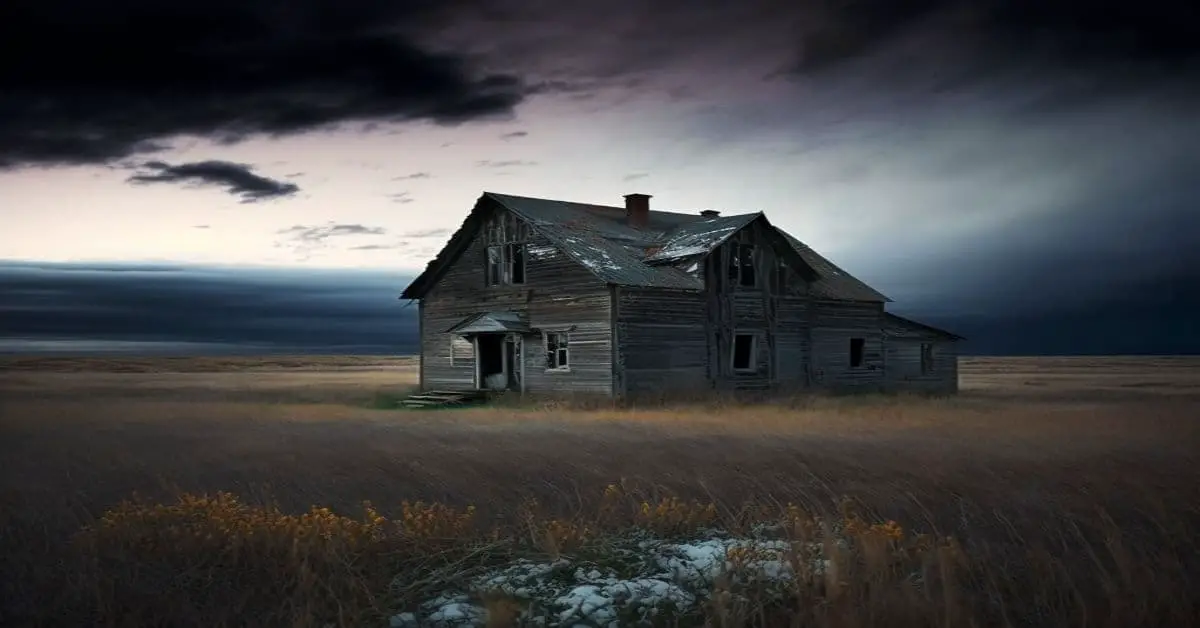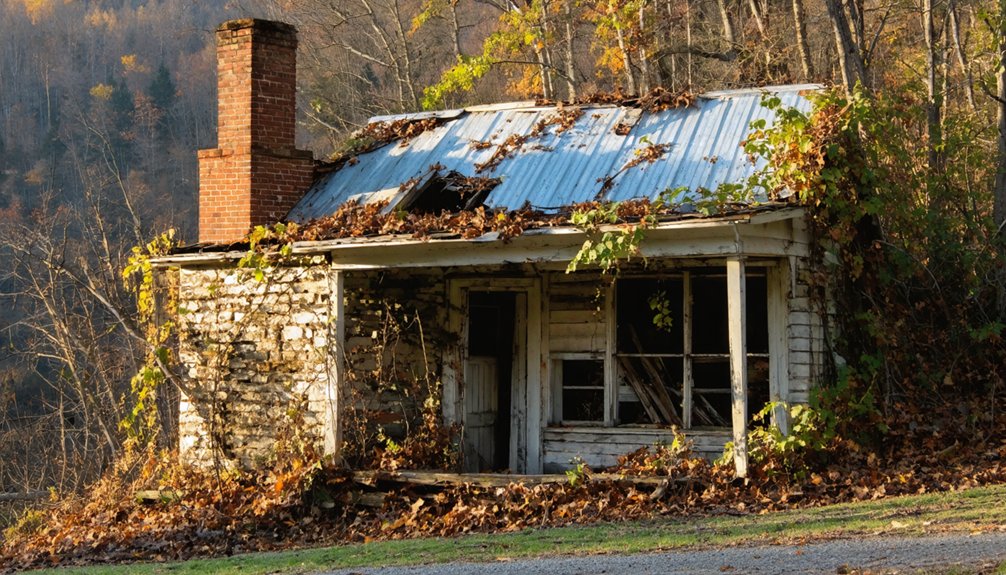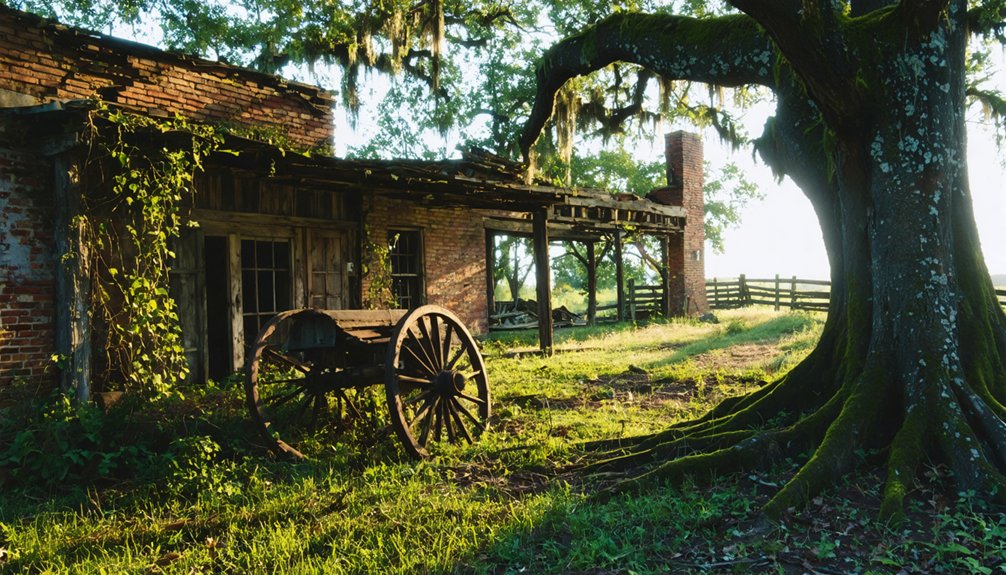You’ll find Violett nestled in northeastern Arkansas County, an abandoned settlement marked by its historic Violet Cemetery (est. 1831) and a solitary church building. The town flourished in the early 1900s with timber operations and tomato canneries before declining after World War I. While nature has reclaimed much of the original settlement, you can still trace the old street grid and discover foundation remnants. The site’s rich history holds countless untold stories of early Arkansas pioneers.
Key Takeaways
- Violett is an abandoned town in northeastern Arkansas County, established around 1876 and marked by its historic cemetery with 634 graves.
- The town’s economy once thrived on agriculture, timber operations, and tomato canneries before declining after World War I.
- A still-standing church building and visible street layout remain, though nature has largely reclaimed the former town site.
- The Violet Cemetery, established in 1831, serves as the main cultural landmark and contains graves of early settlers and veterans.
- The town’s decline was driven by depleted timber resources, job losses, and families relocating to larger towns during economic shifts.
The Lost Town of Violett: A Historical Overview
While much of Arkansas’s early frontier history remains well documented, the story of Violett stands as an enigmatic chapter in the state’s past. You’ll find few written records of this vanished settlement, though its cultural significance lives on through nearby Violet Cemetery, established in 1831.
The town’s exact founding date remains unclear, but you’ll recognize its importance as one of the region’s earliest communities. The cemetery holds approximately 634 marked graves that tell the stories of early settlers, civic leaders, and veterans from multiple wars. Among these graves lies Violet Boles, whose tragic 1922 murder shocked the local community.
What’s known about Violett history comes primarily through scattered records and local heritage sites. The settlement gradually faded as families moved to larger towns, leaving behind only traces of their frontier life.
Today, you’ll discover most tangible connections to Violett through the cemetery’s preserved funerary art and grave markers, silent witnesses to a once-thriving community that helped shape Arkansas’s early development.
Geographic Location and Natural Features
Located in the northeastern reaches of Arkansas County, Violett’s abandoned site offers a window into the state’s rural landscape.
While you won’t find it on modern maps, you’ll discover its geographic significance through a standard grid system and accessible 2-wheel drive roads.
Though absent from current cartography, Violett’s location reveals itself through basic road grids and easily navigable pathways.
Historical records from John Nelson Carlin’s homestead in 1876 mark this location’s earliest documented settlement. The natural habitat surrounding Violett showcases the region’s typical mixed forests and grasslands, creating an ideal environment for the area’s abundant duck populations. Similar to the Buffalo River area, the land features numerous hiking trails through dense woodland.
- Experiences distinct seasonal changes with cold winters and hot summers
- Best visiting conditions occur during spring and fall months
- Sits within a region known for significant waterfowl migration patterns
- Accessible terrain allows for easy exploration of the abandoned site
- Preserves characteristic elements of Arkansas County’s natural environment
Rise and Fall of a Settlement
The story of Violett’s rise and fall mirrors many Arkansas frontier settlements of the 1800s. You’ll find its beginnings tied to the early establishment of a post office in 1832, when the town was still called Bartholomew.
The settlement’s economic adaptation revealed itself through various industries – from agriculture and timber operations to tomato canneries as resources shifted. Unlike towns like Rush Historic District, which preserved their buildings, Violett left little physical evidence of its existence.
The town’s community resilience showed in its vibrant social life during the 1910s and 1920s, with hotels, dance halls, and pool halls drawing locals together. Much like Monte Ne, the town’s fate was sealed by economic changes in the region.
But like many frontier towns, Violett couldn’t survive the perfect storm of depleted timber resources after World War I, mechanization of farming, and the subsequent loss of jobs.
As businesses closed and people moved away, the town’s liveliness faded, leaving behind another Arkansas ghost town.
What Remains Today: Site Assessment
Standing as a monument to Violett’s past, today’s site reveals a mix of visible remnants and natural reclamation. Your site exploration will uncover the most prominent feature – the still-standing church building – amid streets that remain clearly visible despite decades of abandonment. The area’s most striking visual element is the bright blue water contrasting dramatically against the surrounding landscape. Like the historical town of Rush, zinc mining operations once brought prosperity to this region before its decline.
A structural assessment shows nature’s steady reclaiming of the landscape, with vegetation covering much of the former townsite. You’ll find the limestone mine area exists but remains off-limits on private property.
- The church structure stands as the last major building, though deteriorating
- Original street layout remains identifiable through the overgrowth
- Foundation remnants hint at former residential locations
- Native and non-native plants have naturalized throughout the site
- Mining-related terrain features persist but are largely inaccessible
Exploring Arkansas Ghost Town Heritage
You’ll find that Arkansas ghost towns like Violett offer unique windows into the state’s economic and social history, preserved through local historical societies‘ documentation efforts and remaining physical artifacts.
Like Arkansas Post, Violett developed as a crucial trading hub in early Arkansas where settlers and travelers exchanged goods along key transportation routes.
Many towns like Violett experienced decline similar to Calico Rock when silver mining collapsed, leading to widespread abandonment as residents sought opportunities elsewhere.
While Violett doesn’t maintain formal tourist facilities, you can explore the site’s heritage through archived photographs, oral histories, and occasional guided tours arranged by regional preservation groups.
The abandoned town’s impact on local culture persists through community storytelling, family histories, and its role in shaping nearby communities’ development after residents relocated.
Historical Preservation Methods Today
Modern preservation efforts in Arkansas’s ghost towns involve a coordinated network of organizations, techniques, and resources working to protect these invaluable historical sites.
You’ll find Preserve Arkansas leading the charge, offering technical assistance and preservation techniques that help maintain these historic treasures. Community involvement plays an essential role through partnerships with property owners and local advocates who understand the importance of protecting our heritage.
- On-site consultations and educational resources guide preservation efforts
- National Park Service Preservation Briefs provide material-specific guidance
- Secretary of Interior’s Standards outline four treatment approaches
- Local partnerships prioritize preservation needs and create action plans
- Arkansas Heritage Preservation Program offers specialized cemetery preservation guidelines
These collaborative efforts guarantee that Arkansas’s ghost towns remain protected while adapting to modern needs, though challenges like funding and neglect continue to threaten these historic sites.
Ghost Town Tourist Appeal
Why do abandoned towns captivate so many visitors to Arkansas?
You’ll find ghost town tourism offers a powerful blend of adventure and history, especially in places like Violett. You’re not just exploring empty buildings – you’re stepping into tangible connections to Arkansas’s industrial past.
The cultural significance of these sites runs deep, enhanced by thoughtful interpretive features that tell stories of boom, bust, and resilience.
You can safely explore designated viewing areas while seasonal changes create ever-shifting photo opportunities. Many sites are conveniently located near major cities, making day trips practical.
Whether you’re drawn to spring wildflowers or fall foliage, you’ll appreciate how these preserved spaces offer both solitude and educational value. Local businesses benefit too, as heritage tourism brings curious explorers to the region.
Local Community Cultural Impact
Beyond drawing tourists, Violett’s abandoned structures shape the cultural fabric of surrounding Arkansas communities in profound ways.
You’ll find that preservation efforts have transformed these historic ruins into powerful anchors for community storytelling and cultural narratives. Local residents gather to share tales of pioneer life, mining adventures, and mysterious happenings that strengthen their shared heritage and regional identity.
- Local history groups lead educational walking tours that connect today’s residents with their pioneer roots.
- Community-organized preservation projects foster civic pride and social bonds.
- Heritage events in and around Violett unite neighbors through shared historical interests.
- Local schools use the site as an outdoor classroom for hands-on history lessons.
- Folk traditions and ghost stories tied to the town enhance intergenerational connections.
Planning Your Visit to Violett

Since Violett isn’t a documented ghost town location, you’ll want to focus your ghost town explorations on verified sites like Rush or Monte Ne where safety protocols are established.
When visiting any Arkansas ghost town, you should pack essential safety gear including sturdy boots, a first aid kit, and plenty of water while planning your visit during spring or fall months to avoid extreme temperatures.
You’ll need to obtain necessary permissions, respect posted warnings, and inform someone of your plans before heading out to explore these historical sites.
Essential Safety Precautions
Before exploring the abandoned remains of Violett, Arkansas, you’ll need to take several critical safety measures to guarantee a successful visit.
Pack essential safety gear including a first aid kit, sturdy boots, and protective gloves to navigate unstable terrain safely. Always travel with companions and inform others of your plans, as cell service can be unreliable in this remote location. Stay alert for wildlife encounters – snakes and insects are common in these abandoned areas.
- Bring recovery equipment if accessing by vehicle, including winch points and tow straps
- Pack plenty of water and weather-appropriate clothing
- Use GPS devices and detailed maps to prevent getting lost
- Avoid entering deteriorating structures that may collapse
- Follow Leave No Trace principles and don’t remove historical artifacts
Best Times To Visit
Throughout the year, spring and fall offer the most rewarding times to visit Violett’s historic site, with moderate temperatures ideal for exploration and photography.
You’ll find the best visiting conditions during these shoulder seasons, when you can avoid summer’s intense heat and winter’s harsh cold.
Spring brings blooming flora and excellent natural lighting for photos, while fall treats you to crisp air and vibrant foliage.
These season benefits extend to road conditions too – the 2WD-accessible routes are typically dry and manageable during spring and fall months.
Since there aren’t any facilities on-site, you’ll want to take advantage of these milder seasons for comfort during your exploration.
Remember to pack essentials and check weather forecasts, as conditions can change quickly in these shifting seasons.
Preserving Violett’s Legacy for Future Generations
While many Arkansas ghost towns have faded into obscurity, preserving Violett’s legacy requires a multi-faceted approach combining historical documentation, physical site protection, and community engagement.
You’ll find that digital archiving and local participation are essential to keeping Violett’s story alive for future generations. Through coordinated preservation efforts, you can help protect what remains while sharing its history with others.
- Partner with historical societies to document and validate oral histories from local families
- Create digital archives of photographs, documents, and maps for researchers
- Implement site protection measures to prevent erosion and vandalism
- Develop educational programs with local schools for hands-on history learning
- Organize community events to foster local stewardship and heritage appreciation
Frequently Asked Questions
Are There Any Documented Supernatural Occurrences at Violett’s Abandoned Site?
You won’t find any documented ghost sightings or haunted history at this site. Unlike other Arkansas locations known for paranormal activity, there’s no evidence of supernatural occurrences in Violett’s remains.
What Native American Tribes Originally Inhabited the Violett Area?
You’ll find the Osage and Quapaw tribes were the primary Native American inhabitants of this land, with the Caddo Nation also having significant tribal history throughout the broader region.
Did Any Famous Historical Figures Ever Visit Violett?
Like searching for footprints in fog, you won’t find evidence of historical visits or notable residents in Violett, since records show this location wasn’t actually a real town.
Were There Any Significant Mining or Industrial Operations Near Violett?
You’ll find coal mining was the main industrial impact near Violett, as Franklin County produced 14% of Arkansas’s coal from 1880-1976. Small-scale quarrying and mineral extraction also shaped the area’s mining history.
What Was the Peak Population of Violett During Its Most Active Period?
Like searching for a needle in a haystack, you won’t find concrete numbers for Violett’s peak population. Records about Violett’s history and economy have vanished into the mists of time.
References
- https://encyclopediaofarkansas.net/entries/violet-cemetery-7746/
- https://www.localguidesconnect.com/t/ghost-story/399488
- https://arkansasfrontier.com/ghost-towns-in-arkansas/303766/
- http://freepages.rootsweb.com/~gtusa/history/usa/ar.htm
- https://www.youtube.com/watch?v=3oZuUMZk_Eo
- https://en.wikipedia.org/wiki/List_of_ghost_towns_in_Arkansas
- https://kids.kiddle.co/List_of_ghost_towns_in_Arkansas
- https://www.ghosttowns.com/states/ar/violett.html
- https://www.islands.com/1938535/rush-arkansas-once-thriving-mining-destination-abandoned-ghost-town-eerie-homes-hikes/
- https://psnprofiles.com/guide/21921-frontier-hunter-erzas-wheel-of-fortune-map-guide



